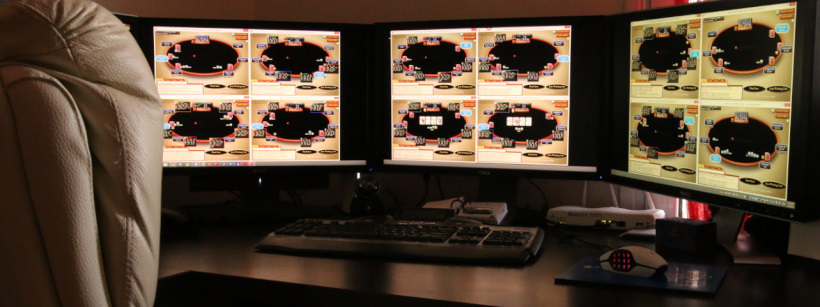There's no way around it, playing online poker involves spending a lot of time behind the computer screen, usually in a sitting position. Sitting is often referred to as smoking of the 21st century. The human body isn't exactly compatible with a desk job (poker or otherwise) and sitting still for long periods of time can cause many different problems from increased risk of cardiovascular disease, to RSI, nerve impingement's etc. Let's look at the classic computer work space setup of a poker player bit by bit and figure out how to optimize our software, hardware and behaviour to minimize the risks associated with sitting down for long periods of time.
Monitor
The top of the monitor should be somewhere around your eye level. Some monitors are easily adjustable, others might not be and you'll need to come up with some creative solution like putting your monitor on a stand (you can use books, boxes etc.). Your display should also be positioned approximately an arms length away from your face. You should avoid leaning over. Maintain neutral shoulder position.
Here are some examples of solid modern monitors:
Chair
Make sure that you're using a chair with proper support for your body that offers you a lot of different adjustments so you can assume healthy and comfortable position every time. For more information about picking a chair that's suitable for poker take a look at this article.
Desk
While we're usually adjusting other components of our set-up to our desk and not the other way around, having a desk that is height-adjustable can be a real godsend, especially when you can use it as a standing desk. Using a standing desk has many health benefits and can boost your concentration so even if you're not planning on using that solution full time, consider adding one or two hours of work behind a standing desk to your routine if you can.
Mouse and Keyboard
The mouse and keyboard should be at the same height as your elbows when your shoulders are relaxed. It makes a lot of sense to have the keyboard tilted slightly away from you because it can prevent you from compressing nerves running through your elbow and wrist to the fingers. It's very important that you choose computer peripherals that are comfortable and easy for you to use.
Here's a selection of good modern keyboards from very cheap to slightly more pricey options:
- Microsoft Comfort Curve 3000
- Logitech K360
- Microsoft Natural Ergo 4000
- Corsair Vengeance K70
- Razer BlackWidow
And here are some examples of comfortable gaming mice that are perfect for poker players:
Software
Table Ninja, Table Tamer, Ipoker Betpot and other programs that allow you to set up hotkeys can greatly streamline your controls and ensure the economy of your movements. Keeping your right hand on the mouse at all time for hours on end (which is often necessary when playing poker without the aid of the aforementioned software) can lead to very unpleasant conditions like carpal tunnel syndrome and ulnar nerve entrapment. If you feel numbness or pain in your fingers you should consult a physician and adjust your workspace based on the tips provided above.
Taking Breaks and Exercise
You can reinforce good workspace ergonomics with regular breaks combined with exercise. Spending five minutes every hour on some very light exercises like lunges, calf raises and shoulder shrugs can loosen up your joints and improve blood circulation in your body, benefiting both your overall health and boosting your focus allowing you to avoid many mistakes that poker players tend to make as a result of a session fatigue!
 More Top Rated Content
More Top Rated Content
Articles
- Procrastination and Poker
- How to Make a Poker Schedule - Tools You Can Use
- Mindful Breathing | Mental Poker Strategy
Coaching Videos





